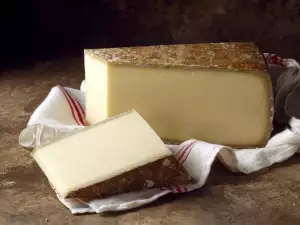Edamer or just Edam, along with the world famous Gouda is among the most popular and liked Dutch cheeses. This dairy product is made from cow's milk and is named after the port of Edam, located in North Holland. Hallmarks of Edam are its oval shape wrapped in red wax rind, making it easily recognizable.
Originally, it is produced in rural farms from unpasteurized cow milk, but in the 19th century, it began to be made from pasteurized, as well as a mixture of two types of milk. Today, Edam is produced in many countries, even its authentic circular cylindrical shape mutates frequently to an elongated block.
Edam cheese enjoys wide popularity in the U.S., Canada, Mexico and Scandinavia. Long time in Spain and Latin American countries, Edam was cherished as a deli product. The cheese is so popular that it has made roots in the culture and art of different nations. Even "East of Eden" by John Steinbeck mentions the delicious cheese.
Edam cheese is still not regulated as "protected brand" of EU law.
History of Edam
Already in the 14th century in North Holland, the production of this kind of lasting cheese was widespread. Through the port city of Edam, the popularity of the cheese spread to France and Spain that same century, and later worldwide. The main reason for this was the good durability of the product and its long shelf life, which proved to be very important for the Mariners in the 14-18th centuries.
There is even a legend that says that the cheese, because of its characteristic round shape, was used for ammunition in ship cannons. Once Edam was made in special wooden forms that local used as helmets in times of war and unrest.
While the legend of its use as shells is a bit dubious, the credibility of this last statement has other evidence. At that time, the Dutch were called by their opponents "cheese heads" because of the wooden molds of Edam helmets.
Initially, the cheese was made from whole milk in rural farms. Later, it began to be made from pasteurized or from a mixture of pasteurized and unpasteurized milk.

Production of Edam
Today, Edam is made from a mixture of pasteurized and unpasteurized milk, mostly from whole or partly skimmed milk. It is made in its typical round shape and in a parallel or block. Usually, Edam weighs from 900 grams to 1.8 kilograms, the most widespread in the supply chain are those weighing 1.7 kg.
The bright red wax rind of Edam is its hallmark. In its native Holland, Edam has a yellow waxy skin, and if you find this Dutch cheese with a black wax rind, this means that the Edam has matured for 17 weeks. Under the red, yellow or black waxy rind lies cheese with a smooth texture and a pale yellow color.
Besides the cakes weighing about 1.7 kg, one might commercially encounter small and cute bombs called "baby Edam." It can be sold in large cakes, double colored with carotene for export. The French twin of Edam is Mimolet.
Interestingly, the Dutch cheese is available without a waxy coating, except during the tourist season. Wax coating provides additional protection for the cakes to be exported from the Netherlands for transport.
Most often, one consumes young Edam cheese, which is more elastic and soft, and the taste is pleasantly sweet with nutty threads. The more mature the Edam is, the taste becomes more acute complex, being spicy with a sharp finish.
Composition of Edam
Compared with other similar cheeses, Edam is not as greasy. Its cousin from the Netherlands - Gouda, contains 48% fat, while Edam has about 40%. In a portion of 100 g Edam cheese, there is 73 percent of the daily requirement of calcium for humans.
100 grams of Edam cheese contain:
357 Kcal
27.8 g fat
1.43 g carbohydrates
24.99 g protein
89 mg cholesterol
965 mg sodium
25 g of protein
Culinary use of Edam
Edam has enjoyed a great popularity not only in the Netherlands, but in many other countries, where this cheese has even become part of the local traditions. Thus the Yucatan dish of Stuffed Cheese (Queso relleno), where an Edam loaf is cut in two, part of it is carved and mixed with vegetables and meat and filled again.
Bake in a special local furnaces to melt the cheese. In the Czech Republic and Slovakia, Edam is an integral part of the most popular breakfast there, together with ham and Tartar Sauce (tatárska omáčka), or mayonnaise. Even in the Philippines, people cherish the taste of Edam, it is served on the eve of the Christmas holidays.
Edam can be served as a main course cheese and dessert. Participates as a supplement and an ingredient in many baked goods, sandwiches, salads and sauces. It has excellent flavor and can be served only with salty crackers and bread.
The aroma and taste are successfully combined with alcohol. If you choose to drink with Edam cheese, you can safely opt for Riesling, Chardonnay, Shiraz, Champagne or even dark beer.










Comments